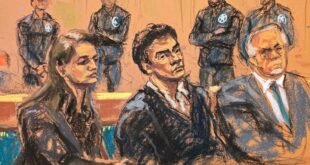
Over 160 works comprise Darrel Ellis: Regeneration at the Bronx Museum, the first institutional survey to honor the late artist. Drawings, paintings, and photographs highlight the Bronx native’s experimental, semi-biographical practice and span a career that sought to reframe Black identity in visual culture and art history. Complementing Ellis’s works is a vast presentation of ephemera: magazines, catalogues, exhibition posters, family photographs, and journals recording the artist’s hopes, fears, and musings. As he grappled with anxieties related to his family, sexuality, and fear of AIDS — to which he would succumb at the age of 33 — Ellis meticulously documented his life. It’s in these details that his voice is preserved.
Throughout his multidisciplinary practice, Ellis appreciated art history, paying homage to artists like Eugène Delacroix, Auguste Rodin, and Édouard Vuillard. He borrowed elements of key works by famous artists, even recreating entire compositions at times. For an untitled work on paper circa 1990, he recreated a photograph of himself taken by close friend and fellow artist Allen Frame. Hanging on a wall behind Ellis in the artwork is an image of a painting he made based on Delacroix’s “Hamlet and Horatio in the Graveyard” (1839). Ellis’s own version (c. 1980–90) is in the show alongside the work on paper. In his journals, he made notes and sketches based on his frequent visits to local galleries and museums, in particular the Metropolitan Museum of Art. Pulled from an archive of over 50 notebooks, dating back to his high school days, selections of the journals are exhibited in vitrines throughout the show and reveal moments of vulnerability, aspiration, and anxiety.
While looking to the past and the field of art history, dominated by White, male, European artists, Ellis also considered his own history and drew inspiration from another artist: his father. Thomas Ellis was a photographer who died in a police encounter shortly before the younger Ellis was born. Darrel drew inspiration from his father’s photographs of family portraits, everyday events, and festive gatherings. He projected the negatives onto irregular shapes and surfaces and rephotographed the results, distorting and obscuring faces and bodies, sometimes removing them entirely so just a glimpse of the subject remains. “It is impossible presently to try to show a whole — a ‘normal’ reality, since it does not exist,” Ellis wrote in a diary entry from 1987.

By incorporating his father’s negatives, Ellis’s work brings to the fore the notable absence of Black individuals in much of Western art history. Ellis ruminated on Black family life and domestic space by painting, drawing, and photographing the same subjects, in particular portraits of his family members, over and over again. “In general, there has been a conspicuous dearth of self-portraits by black artists,” reads one journal entry from 1990, in which Ellis drafted a letter to art dealers.
The journals also reveal Ellis’s preoccupation with AIDS and mortality. “Do I have AIDS?” reads an entry from 1983. It’s unknown when the artist became sick, but in 1984 his journals started to incorporate notes on vitamins and alternative medicine. He was hospitalized with AIDS-related illnesses in 1991 and died in 1992.
Exhibited in the same vitrine as the 1983 journal are reproductions of photographs that Peter Hujar and Robert Mapplethorpe took of Ellis. Hanging on the wall behind this display are ink and conte crayon works on paper recreating these photographs. Ellis made these in 1989 for Nan Goldin’s pivotal show reflecting on the AIDS crisis, Witnesses: Against Our Vanishing at Artists Space. Hujar and Mapplethorpe had both recently died from AIDS complications.
These connective threads create an intimate, personal lens to view Ellis’s practice. He spent his life and career considering his identity as a Black, queer artist within the context of Western art history and his own family and artistic community. Regeneration offers a poignant, heartbreaking story of the realities Ellis and his colleagues faced, one marked by loss, anxiety, and self-determination.






Darrel Ellis: Regeneration continues at the Bronx Museum (1040 Grand Concourse, Concourse Village, The Bronx) through September 10. The exhibition was organized in collaboration with the Baltimore Museum of Art and curated by Antonio Sergio Bessa, Chief Curator Emeritus at the Bronx Museum, and Leslie Cozzi, curator of Prints, Drawings & Photography at the Baltimore Museum of Art.
Source link

